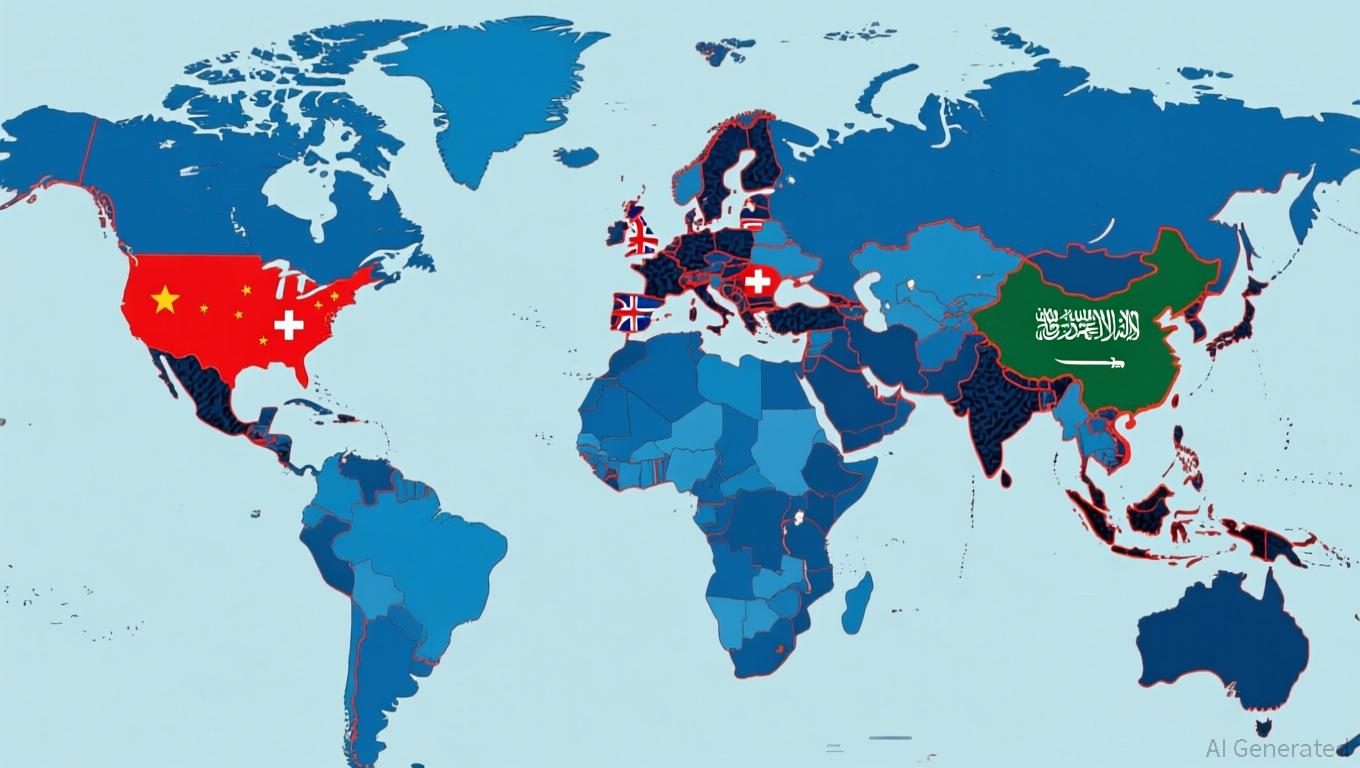ICP's 30% Price Jump: Key Factors and What It Means for Web3 Investors
- ICP surged 30% in late 2025 due to upgraded on-chain governance and tokenomics, enhancing decentralized control and utility-driven demand. - Network Nervous System (NNS) reforms simplified neuron activation, boosted developer participation, and introduced periodic voting reaffirmations. - Caffeine AI integration and partnerships with Microsoft/Google drove TVL to $237B, though dApp usage declined 22.4% amid macroeconomic volatility. - Analysts project $11.15–$31.89 price range for 2026, contingent on sus
ICP’s Remarkable 30% Rally: What’s Fueling the Momentum?
In the latter part of 2025, Internet Computer Protocol (ICP) experienced a significant 30% price jump, drawing considerable interest from both Web3 enthusiasts and major institutional investors. This impressive climb is not merely a short-term spike; it reflects fundamental improvements in ICP’s governance mechanisms and economic structure, which are reshaping its role within the decentralized technology landscape. Let’s explore the key factors behind this growth and their implications for ICP’s future.
A New Chapter in Decentralized Governance
The resurgence of ICP is closely tied to advancements in its Network Nervous System (NNS)—the decentralized governance system that empowers token holders to stake ICP in “neurons” and participate in protocol decisions. In 2025, DFINITY introduced updates that made neuron activation simpler and the governance process more efficient, opening the door for broader community involvement. By lowering barriers to participation, these enhancements have encouraged more users to engage for the long term, aligning the protocol’s economic incentives with its governance outcomes.
One standout feature is the Periodic Confirmation of Following, which prompts neuron holders to reconfirm their voting choices every six months. This approach ensures that only active participants influence governance, fostering a more vibrant and responsive community. The impact is clear: over 2,155 new developers joined the ICP ecosystem in 2025, motivated by initiatives like the Neuron Fund that reward active governance contributors.
Effective governance, however, requires more than just participation—it demands execution. New, stricter voting requirements for certain proposals now encourage manual voting, reducing reliance on automatic approvals and deepening community involvement. While comprehensive data on proposal outcomes after these changes is still emerging, the emphasis on active engagement points to a healthier, more decentralized governance structure.
Tokenomics: Navigating Between Scarcity and Expansion
ICP’s economic model has also undergone significant refinement. The token now serves as the fuel for compute cycles—each transaction burns ICP to access the network’s decentralized resources, introducing a deflationary aspect. This became especially relevant with the July 2025 launch of Caffeine AI, which relies on ICP tokens to operate AI-powered smart contracts. As demand for computational resources grows, so does the rate at which tokens are burned, increasing scarcity and potentially supporting price growth.

Nevertheless, this deflationary pressure is balanced by the risk of inflation. If the expansion of subnets outpaces token burning, ICP’s supply could increase, threatening price stability. The challenge lies in maintaining a careful balance—stimulating innovation and demand while keeping supply growth in check.
Broader economic trends add another layer of complexity. ICP’s price continues to move in tandem with Bitcoin and overall market sentiment. For instance, its recent trading range of $4.00–$5.50 reflects both speculative interest and global economic uncertainty. Investors must consider these external influences alongside ICP’s internal strengths.
Strategic Insights for Web3 Stakeholders
The recent 30% surge is more than a technical or financial event—it signals a strategic shift. ICP’s latest upgrades position it at the forefront of integrating blockchain technology with artificial intelligence, a development that could redefine the value proposition of Web3. The Flux Milestone notably boosted computational power and improved load balancing, allowing canisters to move seamlessly between subnets with minimal interruption. This scalability is vital for attracting both enterprise clients and developers seeking reliable infrastructure.
Institutional interest in ICP has also accelerated. Collaborations with industry leaders such as Microsoft and Google have propelled the network’s Total Value Locked (TVL) to $237 billion by the third quarter of 2025. However, despite this growth in infrastructure, decentralized application (dApp) usage declined by 22.4% during the same period. For ICP to maintain its upward momentum, it must translate speculative excitement into real-world adoption and practical use cases.
Future Prospects: Balancing Risks and Opportunities
ICP’s path forward is not without challenges. Price volatility remains a significant concern, as the token’s history of sharp corrections highlights its speculative nature. The effectiveness of governance proposals will depend on their ability to meet enterprise requirements and keep developers engaged. Should ICP fall short in these areas, recent gains could quickly evaporate.
Despite these risks, the long-term outlook remains cautiously positive. Analysts forecast that ICP could trade between $11.15 and $31.89 in 2026, with the potential to reach $88.88 by 2030—assuming ongoing innovation and a supportive regulatory environment. For investors, key indicators to watch include neuron activation rates, the success of governance proposals, and growth in dApp usage. These metrics will help determine whether ICP can transition from a speculative asset to one driven by real utility.
Summary
ICP’s recent 30% price increase highlights the transformative impact of structural improvements in decentralized networks. By enhancing its governance framework and aligning its tokenomics with genuine demand, ICP has established itself as a strategic player in the Web3 arena. While obstacles remain, the blend of technological progress, growing institutional interest, and an evolving governance model positions ICP as a noteworthy example for those seeking exposure to the next wave of blockchain innovation.
Disclaimer: The content of this article solely reflects the author's opinion and does not represent the platform in any capacity. This article is not intended to serve as a reference for making investment decisions.
You may also like
Switzerland Delays Crypto Information Exchange Pending International Coordination
- Switzerland delays crypto tax data sharing with foreign nations until 2027, citing unresolved CARF partner agreements. - The OECD's 2022 framework requires member states to exchange crypto account details, but 75 countries including the EU and UK face implementation challenges. - Transitional measures ease compliance burdens for Swiss crypto firms while awaiting finalized international data-sharing protocols. - Major economies like the U.S., China, and Saudi Arabia remain outside CARF due to non-complian

Bitcoin Updates: SGX Addresses Offshore Perp Shortfall as Bitcoin Decline Increases Demand for Hedging
- SGX launched Bitcoin and Ethereum perpetual futures, becoming a first-mover in regulated onshore crypto derivatives to meet institutional demand. - The $187B/year perp market, dominated by Asia, now gains a regulated alternative to offshore platforms with SGX's 22.5-hour trading window. - Perps enable hedging during Bitcoin's 2025 downturn, with SGX's margin-call system prioritizing investor protection over instant liquidations. - Regulatory caution limits access to accredited investors, aligning with gl

Bitcoin News Update: Institutional ETF Adjustments Challenge Key Bitcoin Support Thresholds
- Analysts warn Bitcoin faces 25% drop risk if key support levels fail amid shifting institutional ETF dynamics. - Texas's $5M IBIT purchase highlights growing government interest, but ETFs fall short of direct BTC ownership criteria. - Technical analysis shows Bitcoin trapped in a broadening wedge pattern, with breakdown below $80,000 risking $53k decline. - Institutional rebalancing sees $66M IBIT outflows vs. $171M FBTC inflows, signaling tactical ETF rotation over accumulation. - Abu Dhabi's $238M ETF

XRP News Today: IMF Cautions That Rapid Tokenized Markets Could Intensify Crashes in the Absence of Regulation
- IMF warned tokenized markets like XRP could worsen flash crashes without regulation, citing risks from decentralized systems lacking traditional safeguards. - Report acknowledged tokenization's potential to cut cross-border payment costs but highlighted volatility risks from rapid liquidity loss seen in crypto markets. - SEC's approval of crypto ETFs signals growing institutional acceptance, though regulators emphasize oversight frameworks to mitigate systemic risks. - IMF proposed a global digital marke
